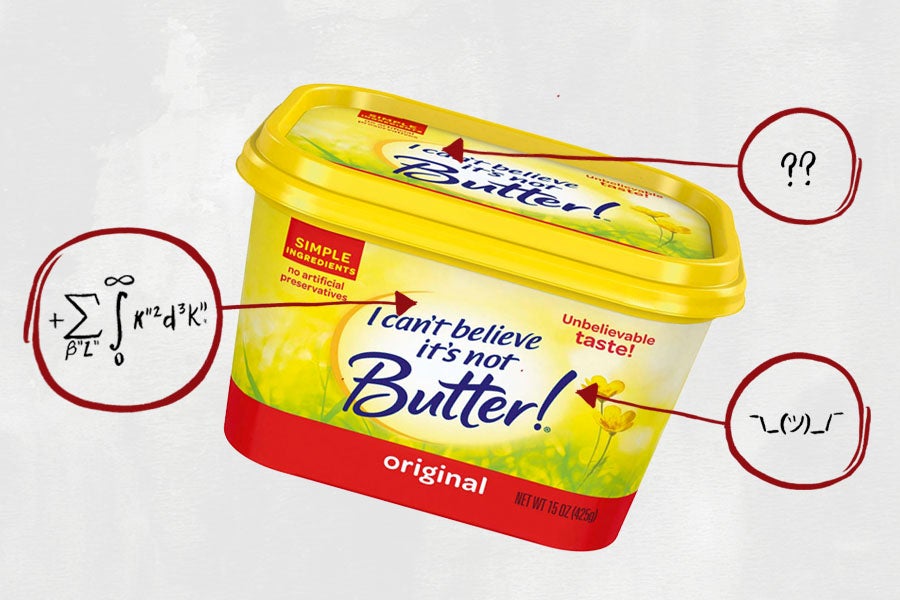We’re often told that you should never eat anything (or put anything on your body) if you don’t recognize everything on the ingredients list. But since most of us have no idea what xanthan gum or potassium benzoate are — or more importantly, what they’re doing to our bodies — we’re decoding the ingredients in the many things Americans put in (and on) themselves with the help of an expert.
This edition: I Can’t Believe It’s Not Butter, which is made from nine separate ingredients that we’ve broken down in the exact order they appear online.

The Ingredients
1) Purified Water: Generally used as a solvent, purified water is just water that’s been distilled or deionized (aka demineralized) to remove impurities like bacteria and microorganisms.
2) Soybean Oil: Physician and biochemist Cate Shanahan, author of Deep Nutrition: Why Your Genes Need Traditional Food, previously told me that consuming too much vegetable oil—which is easy to do, considering Shanahan says roughly 45 percent of the average American’s calories come from refined oils—has serious repercussions (i.e., fatty liver disease, insulin resistance and migraines). While it’s near impossible to eliminate vegetable oil from your diet altogether—major contributors include processed foods, fried foods, frozen pizzas, cakes, cookies, margarines and coffee creamers—it’s best consumed in moderation.
3) Palm Kernel and Palm Oil: As we discovered during our recent ranking of cooking oils by how unhealthy they are, palm oil is one of the least healthy oils available, so again, it’s best consumed in moderation.
4) Salt: For flavor.
5) Lecithin (Soy): Soy lecithin is a component of fat found in (you guessed it!) soy. It’s typically added to food products as an emulsifier. In simpler terms, it helps the numerous ingredients found in I Can’t Believe It’s Not Butter mix together. “It’s also frequently used to extend product shelf life,” Dagan Xavier, ingredient expert and co-founder of Label Insight, told me during our analysis of the ingredients in frozen breakfast sandwiches.
6) Natural Flavors: Natural flavor is quite literally flavors derived from an actual food source—i.e., butter flavoring taken from real butter.
7) Vinegar: This adds a slightly tart flavor.
8) Vitamin A Palmitate: A compound that acts as a source of vitamin A, which supports vision and the immune system.
9) Beta-Carotene (Color): Beta-carotene is a pigment found in plants that gives yellow and orange fruits (like oranges) and vegetables (like carrots) their color.
The Takeaway
According to Dana Hunnes, senior dietitian at the Ronald Reagan UCLA Medical Center, I Can’t Believe It’s Not Butter is “similarly unhealthy” when compared to actual butter. “While it’s trans-fat free, it’s not saturated-fat free,” she explains. (The consumption of saturated fat has traditionally been linked to heart disease, but it’s worth noting that science continues to go back and forth in regard to whether or not saturated fats are actually healthy, so they’re best consumed in moderation.) “These saturated fats are derived from palm oil and palm kernel oil, which are also devastatingly bad for the environment, especially [the habitats] of Asian elephants and orangutans.”
All in all, I Can’t Believe It’s Not Butter is best consumed in moderation. If not for the sake of your own health, it might be worth cutting down the amount you eat for the sake of the elephants and orangutans who become homeless so that you can enjoy some margarine with your pancakes.

